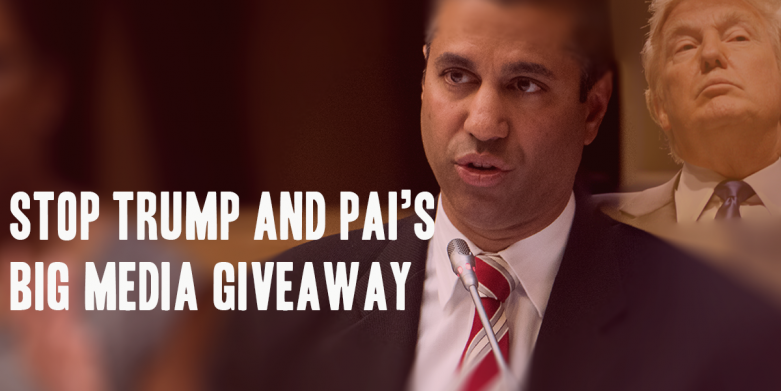
Pai's Big-Media Handout Won't Help Communities
FCC Chairman Ajit Pai claimed in a New York Times Op-Ed Thursday that his ill-conceived plans to overhaul media-ownership rules are in fact a long-overdue move to rescue the struggling newspaper industry.
The chairman’s piece is rife with lies of omission that render his argument meaningless.
Pai cites well-established statistics detailing the decline of the newspaper industry over the past several decades and declares that the FCC must vote on Nov. 16 to undo media-ownership limits to repair this sad state of affairs. In reality, runaway consolidation has been a complete disaster for newspapers, and his changes would only make things worse.
Not to mention the worst of Pai’s proposed rule changes have nothing at all to do with newspapers.
Pai’s order presents a gift basket of deregulatory goodies to big broadcasters like Sinclair. It would end the ban on cross-ownership of local newspapers by television and radio stations in the same market. But it doesn’t end there.
Despite his claim in the Times that the FCC “will continue to prohibit any company from owning more than two television stations in any market,” Pai’s order would gut this crucial protection.
The local television-ownership rule currently prohibits broadcasters from owning two stations in a local market, unless it can demonstrate that eight or more independent broadcast voices would still serve that market, and unless at least one of the stations isn’t ranked among the market’s top-four stations.
Pai plans to scrap the eight-voices test and replace the top-four prohibition with a nebulous “case-by-case review” — which will mean nothing given his pro-merger philosophy.
When working to undermine strong Net Neutrality protections, Pai himself has called such case-by-case review methods a recipe for “regulatory uncertainty” and “the enemy of growth.” But he’s happy to embrace this approach when it suits the needs of big broadcasters.
The only consistent aspect of the chairman’s approach is his dogmatic opposition to effective public-interest protections.
Pai also plans to legitimize a form of shady broadcasting arrangements known as joint sales agreements, or JSAs. JSAs allow big broadcasters like Sinclair to run the news operations of competing stations, undermining and evading the local television-ownership rule. Contrary to all data, analysis and common sense, Pai plans to use the November FCC vote to affirm that this exploitative loophole actually serves the public interest.
In theory, these changes would allow a single broadcaster to own both your local newspaper and your top-two local broadcast stations, plus operate a handful of other stations through sharing agreements — turning your community into a one-newsroom town.
None of Pai’s proposals would resuscitate the newspaper industry. But they would clear the way for approval of Sinclair’s merger with Tribune, which would give Sinclair control of TV stations reaching 72 percent of the U.S. population.
Certainly the media landscape has changed since 1975. Newspapers are struggling to find a viable path forward in the digital age. But traditional media outlets aren’t suffering for lack of consolidation. Both the broadcast and newspaper industries have been hit with massive media mergers. Community owners have been forced out as big conglomerates jockey for negotiating leverage and national ad sales.
Even without the freedom to buy each other, both industries have been cannibalizing themselves just fine.
Does this merger mania help funnel resources into anemic news operations? All signs point to no. Media consolidation has ramped up as the newspaper industry has steadily declined. When media conglomerates gobble up smaller outlets, women and people of color are kept out of the marketplace. Newsrooms are shuttered and journalists are laid off.
Instead of producing more news, big broadcasters just air the same news across multiple channels.
Pai argues that slashing cross-ownership limitations is a matter of “fairness.” He claims that digital goliaths like Google, Facebook and Twitter are being permitted to buy up newspapers while broadcasters are denied. But none of these three companies are buying local media — and they should be scrutinized if they ever try to do so.
This isn’t about fairness; it’s about giant broadcasters seeking out new mergers to satisfy Wall Street’s insatiable appetite for consolidation.
We’ve been trying deregulation and consolidation as strategies to reinvigorate traditional media markets for more than 30 years. It isn’t working. The rules Pai wants to scrap aren’t stifling and obsolete — they’re the last gasps of a consumer-protection model that media conglomerates have spent decades lobbying to death.
If Pai truly wants to reimagine media-ownership rules for a digital era, he should seek feedback from communities and journalists. Instead he’s granting a 10-month-old petition from broadcast lobbyists with zero opportunity for public input or up-to-date research on the impact of these changes.
Pai’s sins of omission are part of a calculated effort to disguise his big-media handout as a gift to the public. Don’t buy it.